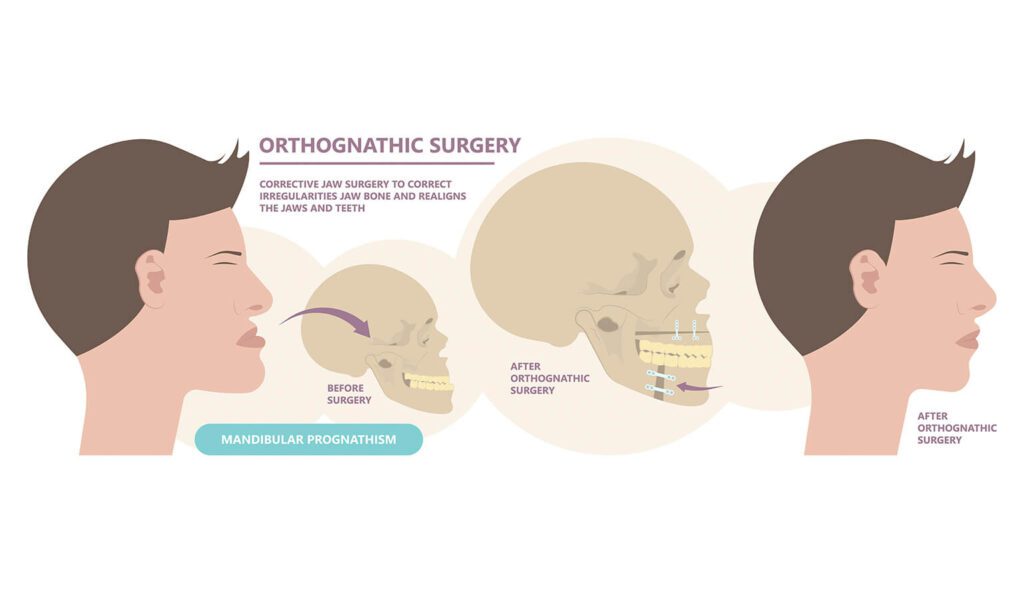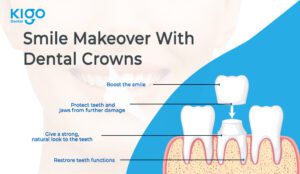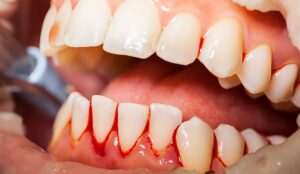Orthognathic surgery
Uncompromised quality
We use quintessential quality materials and stringent sterilisation protocols to ensure that you don't have any medical or dental complications in future.
Anxiety Free Dentistry
Experience the treatment process in a pleasant atmosphere from handpicked expert clinicians, with unparalleled clinical etiquette, to ensure exemplary health care.
Best in class outcomes
We strive our best, so that we can keep our promise of delivering the individualized smiles that we have reimagined for you with latest techniques and technologies.
Orthognathic surgery


Orthognathic surgery, also known as corrective jaw surgery, is a type of surgical treatment that is performed to correct abnormalities in the alignment of the jawbones. The procedure is typically performed by an oral and maxillofacial surgeon in conjunction with an orthodontist.
Orthognathic surgery is often used to treat patients with severe misalignments of the jaw that cannot be corrected through traditional orthodontic treatments, such as braces or aligners. These misalignments can cause a variety of problems, including difficulty chewing and speaking, breathing problems, and sleep apnea. Additionally, the misalignment can cause facial asymmetry and aesthetic concerns that can have a negative impact on self-confidence and quality of life.
The orthognathic surgery process typically begins with a consultation with an orthodontist, who will evaluate the patient’s misalignment and develop a treatment plan. This treatment plan will likely involve the use of braces or other orthodontic appliances to gradually shift the teeth into the correct position. Once the teeth have been properly aligned, the orthodontist will refer the patient to an oral and maxillofacial surgeon who will perform the corrective surgery.
During the surgery, the oral and maxillofacial surgeon will make incisions in the jawbones and reposition them to the correct alignment. The surgeon may also make adjustments to the chin or other facial structures to improve the overall symmetry and balance of the face. The incisions are typically made inside the mouth, which helps to minimize scarring.
After the surgery, you’ll need to continue with orthodontic treatment to fine-tune the bite and ensure that the teeth stay in the proper position. But the end result is well worth the effort, with a healthier, more functional bite and a confident, beautiful smile to show for it.
Following the surgery, patients will need to follow a strict post-operative care plan to ensure proper healing. This will likely include a period of rest, a liquid or soft food diet, and specific oral hygiene practices. Patients will also need to attend regular follow-up appointments with their orthodontist and surgeon to monitor progress and adjust treatment as necessary.
Orthognathic surgery can have a significant impact on a patient’s quality of life. Patients may experience improved breathing, speech, and chewing function, as well as improved facial aesthetics and self-confidence. However, the surgery is not without risks and potential complications, and it is important for patients to carefully consider the risks and benefits before undergoing the procedure.
In conclusion, orthognathic surgery is a powerful treatment option for patients with severe jaw misalignments. With careful planning and expert surgical skill, orthognathic surgery can help patients achieve a more functional, balanced, and aesthetically pleasing smile.
Maxillary Osteotomy: This surgery involves cutting and repositioning the upper jawbone to correct deformities of the upper jaw, such as a narrow or protruding upper jaw.
Mandibular Osteotomy: This surgery involves cutting and repositioning the lower jawbone to correct deformities of the lower jaw, such as an underdeveloped or overdeveloped lower jaw.
Genioplasty: This surgery involves cutting and repositioning the chin bone to correct deformities of the chin, such as a receding or protruding chin.
Bimaxillary Osteotomy: This surgery involves cutting and repositioning both the upper and lower jawbones to correct deformities of both jaws, such as a significant overbite or underbite.
Segmental Osteotomy: This surgery involves cutting and repositioning specific sections of the jawbone to correct localized deformities or asymmetries.
Distraction Osteogenesis: This surgery involves the gradual lengthening of the jawbone using a special device, and is typically used to correct severe deformities or deficiencies of the jaw.
Consultation: The patient meets with an orthodontist to discuss their concerns and goals for the surgery. The orthodontist will also perform an examination and take x-rays and/or scans to assess the patient’s jaw structure and determine the extent of the deformity.
Treatment planning: The orthodontist works with an oral & maxillofacial surgeon to develop a treatment plan that includes both orthodontic treatment to align the teeth and surgical treatment to correct the jaw deformity.
Pre-surgical orthodontics: The patient undergoes orthodontic treatment to prepare their teeth for the surgery. This typically involves wearing braces or other orthodontic appliances to move the teeth into the correct position.
Surgery: The patient undergoes the surgical procedure, which may involve an incision in the mouth or on the face to access the jawbones. The surgeon then repositions the jawbones using specialized surgical tools and techniques, and may use bone grafts or other materials to support the new position.
Post-surgical orthodontics: The patient continues with orthodontic treatment to ensure that their teeth align properly with the new position of the jawbones.
Follow-up: The patient undergoes regular follow-up appointments with the surgeon and orthodontist to monitor their progress and make any necessary adjustments to their treatment plan.
Improved chewing, speech, and breathing function.
Enhanced facial symmetry and aesthetics.
Correction of malocclusions, underbites, overbites, and other jaw-related conditions.
Relief from chronic pain and discomfort related to jaw joint dysfunction (TMJ).
Boost in self-confidence and self-esteem.
Infection: Infections can occur at the surgical site, which can lead to complications and prolong the recovery process.
Bleeding: Bleeding is a common risk associated with any surgery, and may require transfusions or other interventions to manage.
Nerve damage: The surgery can result in temporary or permanent damage to the nerves that control facial sensation or movement.
Swelling and bruising: Swelling and bruising are common after orthognathic surgery and can persist for several weeks.
TMJ disorder: The surgery can alter the position of the jaw, which can increase the risk of developing temporomandibular joint (TMJ) disorder.
Relapse: In some cases, the jaws may shift back to their original position after the surgery, which may require additional treatment.
Dental and occlusal changes: There is a risk that the surgery may cause changes to the occlusion or bite, which can affect dental function and aesthetics.
It is important for patients to closely follow their surgeon’s instructions for post-operative care and attend follow-up appointments to monitor for any potential complications. With proper care and management, the risks of complications can be minimized and optimal outcomes can be achieved.
Malocclusion: Patients with severe bite problems that cannot be corrected with orthodontics alone, such as an underbite, overbite, or crossbite, may require orthognathic surgery.
Facial asymmetry: Patients with significant facial asymmetry or disproportion may require orthognathic surgery to correct the skeletal discrepancies.
Breathing difficulties: Patients with obstructive sleep apnea, airway obstruction, or other breathing difficulties due to jaw or facial skeletal problems may require orthognathic surgery to improve their breathing and overall health.
Speech difficulties: Patients with speech difficulties due to jaw or facial skeletal problems may require orthognathic surgery to improve their speech and communication skills.
Temporomandibular joint (TMJ) disorders: Patients with TMJ disorders, including chronic pain and joint dysfunction, may require orthognathic surgery to correct the underlying skeletal problems that are contributing to their condition.
Aesthetic concerns: Patients who are unhappy with the appearance of their face or jaw may opt for orthognathic surgery to improve their facial harmony and overall appearance.
Sleep apnea: In some cases, orthognathic surgery may be recommended to treat obstructive sleep apnea, a condition in which the airway is partially or completely blocked during sleep.
Facial trauma: Patients with facial trauma or injuries that result in severe jaw misalignment may require orthognathic surgery to restore normal function and appearance.
Ultimately, the decision to undergo orthognathic surgery is based on a thorough evaluation of the patient’s condition and treatment options, and should be made in consultation with a qualified orthodontist and oral and maxillofacial surgeon.
Evaluation and planning: Before the surgery, a thorough evaluation of the patient’s medical and dental history, physical examination, and radiographic analysis is conducted to determine the patient’s suitability for surgery. A team of professionals, including an orthodontist and an oral and maxillofacial surgeon, will develop a comprehensive treatment plan based on the patient’s goals, the severity of the skeletal discrepancy, and the available treatment options.
Preoperative preparation: Patients are typically instructed to discontinue certain medications, avoid smoking, and follow a specific diet before the surgery to optimize their health and minimize the risk of complications.
Anaesthesia: Orthognathic surgery is typically performed under general anaesthesia, which is administered by an anaesthesiologist with experience in providing anaesthesia for this type of procedure.
Incisions: The surgeon will make incisions in the jawbones to access and reposition them. The location and size of the incisions will depend on the specific needs of the patient.
Repositioning of the jawbones: The surgeon will reposition the jawbones to correct the skeletal discrepancy. In some cases, bone grafts or other materials may be used to stabilize the bones in their new position.
Postoperative care: After the surgery, patients are monitored closely to ensure proper healing and to manage any complications that may arise. They are typically instructed to follow a specific diet, take pain medication, and avoid strenuous activities for several weeks. Follow-up appointments with the surgeon and orthodontist are necessary to monitor the progress of the treatment and make any necessary adjustments.
Orthodontic treatment: Most patients will require orthodontic treatment before and after the surgery to ensure that their teeth are properly aligned with their new jaw position. This may involve the use of braces, retainers, or other orthodontic appliances.
Overall, orthognathic surgery is a complex procedure that requires careful evaluation, planning, and execution to achieve the desired outcomes. A team of professionals, including an orthodontist and an oral and maxillofacial surgeon, will work together to develop a comprehensive treatment plan that meets the patient’s individual needs and goals.
All of us here at Kigo Dental are committed to providing you with the best dental care available, and we do so with a smile.
Our entire staff, from receptionists to dental hygienists and assistants, is committed to providing you with the best quality dental care possible
From the time you walk through the door and every time you revisit, you will experience this firsthand.
Kigo Dental has a team of experienced and skilled Orthodontists and other specialised dentists who specialise in providing high-quality dental care and treatments, utilising the latest technologies and techniques to ensure the best outcomes for their patients.
FAQ's
Orthognathic surgery, also known as corrective jaw surgery, is a surgical procedure used to correct severe jaw misalignments and related bite problems that cannot be corrected with more conservative treatments, such as braces or dental appliances.
The benefits of orthognathic surgery can include improved chewing, speaking, and breathing, enhanced facial aesthetics, reduced risk of tooth damage and wear, and improved quality of life.
Good candidates for orthognathic surgery are typically individuals with a severe jaw misalignment or bite problem that cannot be corrected with more conservative treatments, such as braces or dental appliances. The best way to determine if you are a good candidate for orthognathic surgery is to consult with a qualified orthodontist or an oral & maxillofacial surgeon.
The recovery process after orthognathic surgery can vary depending on the individual patient and the specific procedure performed. In general, patients can expect to be on a soft or liquid diet for several weeks and may need to avoid strenuous activities or exercise for a period of time. Full recovery can take several months.
Like any surgical procedure, orthognathic surgery carries some risks and potential complications, such as bleeding, infection, nerve damage, and relapse. However, these risks can be minimized by carefully following pre- and post-treatment instructions and working with a qualified surgical team.
The length of the surgery will depend on the complexity of the case, but generally, it takes between 2 to 6 hours.
The surgeon will make incisions in the jawbones and reposition them to correct the skeletal discrepancy. In some cases, bone plates or other materials may be used to stabilize the bones in their new position.
The recovery process will vary depending on the individual case, but generally, patients will need to follow a specific diet, take pain medication, and avoid strenuous activities for several weeks. They will also need to attend follow-up appointments with their orthodontist and surgeon to monitor their progress.
Yes, most patients will need to wear braces for a period of time after the surgery to ensure that their teeth are properly aligned with their new jaw position.
As with any surgery, there are risks associated with orthognathic surgery, including bleeding, infection, nerve damage, and anesthesia-related complications. However, these risks can be minimized with careful evaluation, planning, and execution of the surgery.
The final results of the surgery will depend on the individual case, but generally, it can take several months to a year for the full benefits of the surgery to be realized.
Blogs






Wisdom Teeth: Understanding the What, Why, and When
Wisdom teeth, also known as third molars, are often a source of concern for many people. They can lead to various dental issues, including wisdom






Smile Makeover with Dental Crowns: Types, Overview & cost
A smile is one of the most attractive features a person can have. It can boost your confidence, make you more approachable, and even improve






Beyond the smile: Exploring the crucial role of teeth in your overall health
Teeth are often linked to the ability to smile, eat, and express oneself. However, teeth serve many other vital purposes as well. Your teeth have






The Silent Threat: How Gum Diseases Lead to Tooth Loss
Having strong teeth and gums is a reflection of your entire well-being, not simply your appearance. Despite this, many people don’t give their gums the






The Importance of Orthodontists in Clear Aligner Treatment: Avoiding Problems and Ensuring Successful Outcomes
More and more individuals are seeking out clear aligner treatment as a way to improve their smile in a way that is both subtle and






Understanding Abnormal Dental Habits in Children and the Importance of Control
As parents and caregivers, we play a pivotal role in shaping our children’s habits and behaviors, especially when it comes to their oral health. However,






Wisdom Teeth: Understanding the What, Why, and When
Wisdom teeth, also known as third molars, are often a source of concern for many people. They can lead to various dental issues, including wisdom






Smile Makeover with Dental Crowns: Types, Overview & cost
A smile is one of the most attractive features a person can have. It can boost your confidence, make you more approachable, and even improve






Beyond the smile: Exploring the crucial role of teeth in your overall health
Teeth are often linked to the ability to smile, eat, and express oneself. However, teeth serve many other vital purposes as well. Your teeth have






The Silent Threat: How Gum Diseases Lead to Tooth Loss
Having strong teeth and gums is a reflection of your entire well-being, not simply your appearance. Despite this, many people don’t give their gums the






The Importance of Orthodontists in Clear Aligner Treatment: Avoiding Problems and Ensuring Successful Outcomes
More and more individuals are seeking out clear aligner treatment as a way to improve their smile in a way that is both subtle and






Understanding Abnormal Dental Habits in Children and the Importance of Control
As parents and caregivers, we play a pivotal role in shaping our children’s habits and behaviors, especially when it comes to their oral health. However,






Wisdom Teeth: Understanding the What, Why, and When
Wisdom teeth, also known as third molars, are often a source of concern for many people. They can lead to various dental issues, including wisdom






Smile Makeover with Dental Crowns: Types, Overview & cost
A smile is one of the most attractive features a person can have. It can boost your confidence, make you more approachable, and even improve






Beyond the smile: Exploring the crucial role of teeth in your overall health
Teeth are often linked to the ability to smile, eat, and express oneself. However, teeth serve many other vital purposes as well. Your teeth have






The Silent Threat: How Gum Diseases Lead to Tooth Loss
Having strong teeth and gums is a reflection of your entire well-being, not simply your appearance. Despite this, many people don’t give their gums the






The Importance of Orthodontists in Clear Aligner Treatment: Avoiding Problems and Ensuring Successful Outcomes
More and more individuals are seeking out clear aligner treatment as a way to improve their smile in a way that is both subtle and






Understanding Abnormal Dental Habits in Children and the Importance of Control
As parents and caregivers, we play a pivotal role in shaping our children’s habits and behaviors, especially when it comes to their oral health. However,






Wisdom Teeth: Understanding the What, Why, and When
Wisdom teeth, also known as third molars, are often a source of concern for many people. They can lead to various dental issues, including wisdom






Smile Makeover with Dental Crowns: Types, Overview & cost
A smile is one of the most attractive features a person can have. It can boost your confidence, make you more approachable, and even improve






Beyond the smile: Exploring the crucial role of teeth in your overall health
Teeth are often linked to the ability to smile, eat, and express oneself. However, teeth serve many other vital purposes as well. Your teeth have






The Silent Threat: How Gum Diseases Lead to Tooth Loss
Having strong teeth and gums is a reflection of your entire well-being, not simply your appearance. Despite this, many people don’t give their gums the






The Importance of Orthodontists in Clear Aligner Treatment: Avoiding Problems and Ensuring Successful Outcomes
More and more individuals are seeking out clear aligner treatment as a way to improve their smile in a way that is both subtle and






Understanding Abnormal Dental Habits in Children and the Importance of Control
As parents and caregivers, we play a pivotal role in shaping our children’s habits and behaviors, especially when it comes to their oral health. However,






Wisdom Teeth: Understanding the What, Why, and When
Wisdom teeth, also known as third molars, are often a source of concern for many people. They can lead to various dental issues, including wisdom






Smile Makeover with Dental Crowns: Types, Overview & cost
A smile is one of the most attractive features a person can have. It can boost your confidence, make you more approachable, and even improve






Beyond the smile: Exploring the crucial role of teeth in your overall health
Teeth are often linked to the ability to smile, eat, and express oneself. However, teeth serve many other vital purposes as well. Your teeth have






The Silent Threat: How Gum Diseases Lead to Tooth Loss
Having strong teeth and gums is a reflection of your entire well-being, not simply your appearance. Despite this, many people don’t give their gums the






The Importance of Orthodontists in Clear Aligner Treatment: Avoiding Problems and Ensuring Successful Outcomes
More and more individuals are seeking out clear aligner treatment as a way to improve their smile in a way that is both subtle and






Understanding Abnormal Dental Habits in Children and the Importance of Control
As parents and caregivers, we play a pivotal role in shaping our children’s habits and behaviors, especially when it comes to their oral health. However,
LET'S TALK
Book your Appointment
Appointment Timings: Mon-sat: 10:00 am- 8:00 pm |
Sun: 10:00 am - 1:00 pm
Contact
We would love to be a part of your Smile Reimagining Journey...
- 2nd Floor, QUBE, Plot No: 3-64/A, Kavuri Hills Rd, Jubilee Hills, Hyderabad, Telangana 500033
-
+91 9998884398
- kigodental@gmail.com
-
Mon - Sat: 10:00 am - 8:30 pm
Sun: 10:00 am - 1:00 pm